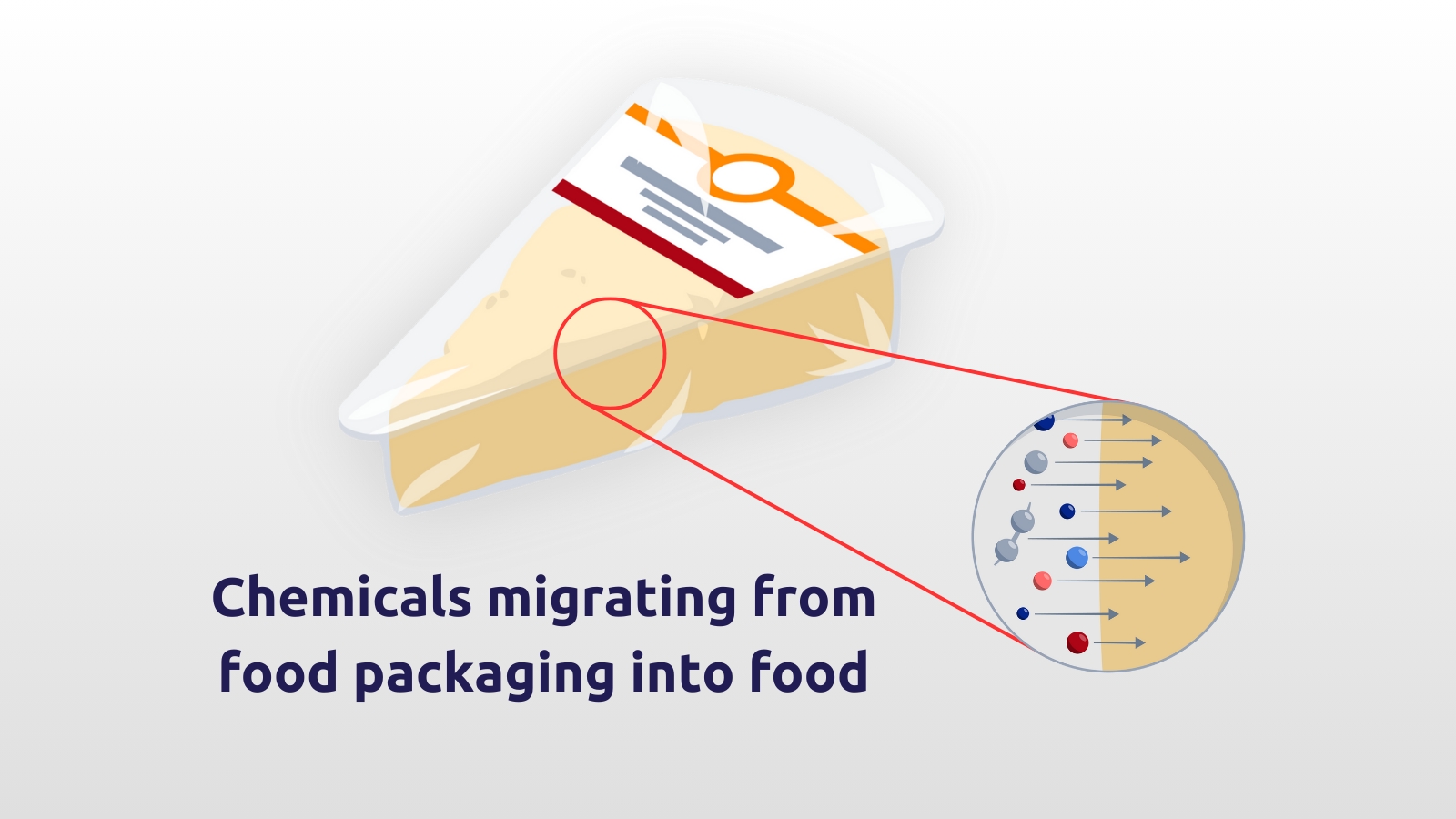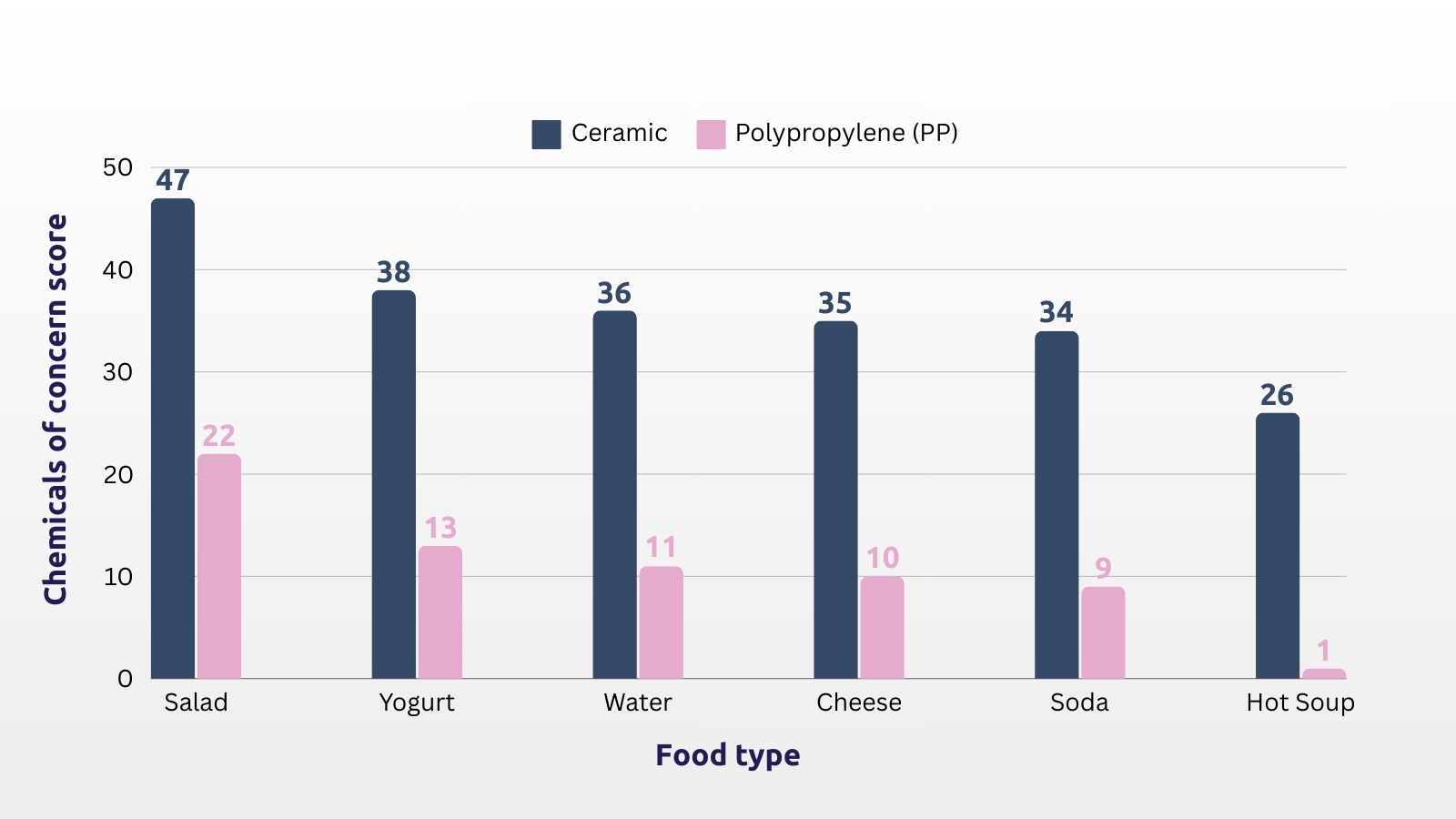⚗️Chemicals of Concern
The presence of toxic chemicals in food packaging associated with harm to humans and the environment is well documented. Hundreds of different harmful substances can be present in the various types of materials used in food packaging, and they can migrate in different amounts and at different rates depending on many factors.
Certain chemicals are linked to negative human health effects when consumed through this pathway - these are referred to as Chemicals of Concern (CoCs). You can download the CoCs considered with the UP Scorecard as defined by the Food Contact Chemicals Priority (FCCprio) List.
Sustainable foodware must be safe for both the environment and humans. With this metric, the UP Scorecard helps to ensure this by considering whether foodware or packaging items contain CoCs, guiding users to avoid the most concerning substances and move towards healthier materials.

Food Contact Chemicals and Migration
Food contact materials (FCMs) are used to make food contact articles (FCAs) that come into contact with food and beverages during, for example, processing, storing, packaging, or consumption. The chemicals within these FCMs and FCAs are known as food contact chemicals (FCCs).

FCCs are found in all food contact materials. Over 15'000 FCCs are known to be intentionally added substances (IAS; such as additives and processing aids). There can also be thousands (up to 100'000 according to some experts) of non-intentionally added substances (NIAS; such as impurities, contaminants, breakdown products, and reaction by-products) present in FCMs.
There is scientific evidence that many FCCs can migrate from foodware and packaging into foodstuffs: thousands of FCCs have been detected in migrates and extracts from food contact materials and articles.

Chemicals of Concern
FCCs can contaminate food when they migrate into the food, resulting in human exposure to complex chemical mixtures. Some FCCs have hazard properties defined as harmful. They are known as Chemicals of Concern (CoCs), and they can affect both the environment and human health in many different ways.

FCCs are present in FCMs, they can migrate into foodstuff, and potentially end up being ingested by humans. Various international biomonitoring programs, databases, and primary literature now provide evidence that hundreds of FCCs have been found in human bodies.

Considering the scientific evidence, reducing or eliminating CoCs from foodware and packaging is a critical step towards safer and more sustainable products and food systems. The CoC metric within the UP Scorecard is meant to guide decision-makers who want to improve their chemical safety standards for foodware and packaging.
Indicator: scale from 2 - 20
To provide a starting point and pathway to safer foodware and packaging, a matrix approach was developed that considers (1) the presence of chemicals of concern in the packaging material, and (2) the migration potential of chemicals in the food being packaged. These scores are then combined to calculate (3) an overall CoC score.
Where only limited or highly uncertain data were available to inform the score, this is visually communicated to the user on the scorecard's results page. More details are available in the Chemicals of Concern section of the full methodology document.
Presence Score
To evaluate the human health impact of a foodware or packaging article, the first aspect to address is whether there are any intentionally added and potentially harmful chemicals in a product. The UP Scorecard does this by asking users to check for these chemicals and then to disclose the reliability of this claim.
Compliance with the FCCprio List
Providing that the information is available (or can be obtained by talking with manufacturers or suppliers), users can compare the chemicals intentionally used in manufacturing a product with the Food Packaging Forum's Food Contact Chemicals Priority (FCCprio) List.

Compliance with the FCCprio List's tiers of priority chemicals can help suppliers and purchasers stay ahead of future regulations and consumer concerns. If a product does not intentionally contain any of the 1,200+ chemicals listed in the 4 tiers, it can get the highest score. If at least one chemical from tier 1 is intentionally present, the product gets the worst score. The score can be progressively improved by manually confirming that chemicals from tiers 1, 2, 3, and 4 are not intentionally used in the product.
Applying a Disclosure Level
The scorecard also rewards the disclosure level used to declare compliance with the FCCprio List. Users can declare different levels of disclosure that a product does not intentionally contain any of the chemicals in one or more of the tiers:

Migration Potential Score
Beyond just containing a chemical of concern, another important aspect is the likelihood of the chemical migrating into the food (and exposing the consumer). This is directly linked to the inertness of the food contact material (material inertness) and to the conditions in which the food contact article is used (defining food and material interactions).
Material Inertness
The release of chemicals into food depends on the inertness of the material, which describes how possible it is for chemicals to move into and out of the material. Some materials are endowed with extremely high barrier properties (they do not let any chemical through), while other more porous materials have very poor barrier properties. In the UP Scorecard, generic food contact materials were scored by scientific experts from very low to very high migration potential (see Section 4.5 of the full methodology document for details).
Beyond just describing the migration of intentionally used CoCs, considering the material inertness also helps to take into account the potential migration of many additional chemicals that can be present known as non-intentionally added substances (NIAS). These are often entirely unknown and untested chemicals present in a material as contaminants, degradation products, or reaction by-products from the production process. They too can have hazardous properties and threaten consumer health.

Food and Material Interaction
There is scientific evidence showing that the release of chemicals from foodware and packaging into foodstuffs is influenced by various factors characterizing the storage and usage conditions.
Such factors include storage time, temperature, fat content, acidity, as well as container size.

In the UP Scorecard, an example worst-case scenario with the highest food and material interactions (leading to the most chemical migration) would be a hot, oily, acidic soup served in a small cup. A pre-defined set of common foods is available in the scorecard for users to apply. Users can also create and save custom foods to use in their product comparisons by providing some basic information about the food's properties and storage conditions.
Overall Chemicals of Concern Score
The overall CoC score combines the Presence Score and the Migration Potential Score as shown in Equation 1. This score is then linearly normalized to be within the range of 1 (worst) to 100 (best) so as to match the scoring range of the other five metrics.

Example Scores
The graphic below shows the default CoC score for a highly inert material (ceramic) and a less inert material (PP). The graphic also shows the influence of the foodstuff being packaged on the CoC score. In both cases, the default compliance score is assumed (meaning that CoCs may be intentionally used in both products). A user could manually improve the scores by confirming compliance with the FCCprio List based on a high disclosure level.

Last updated




